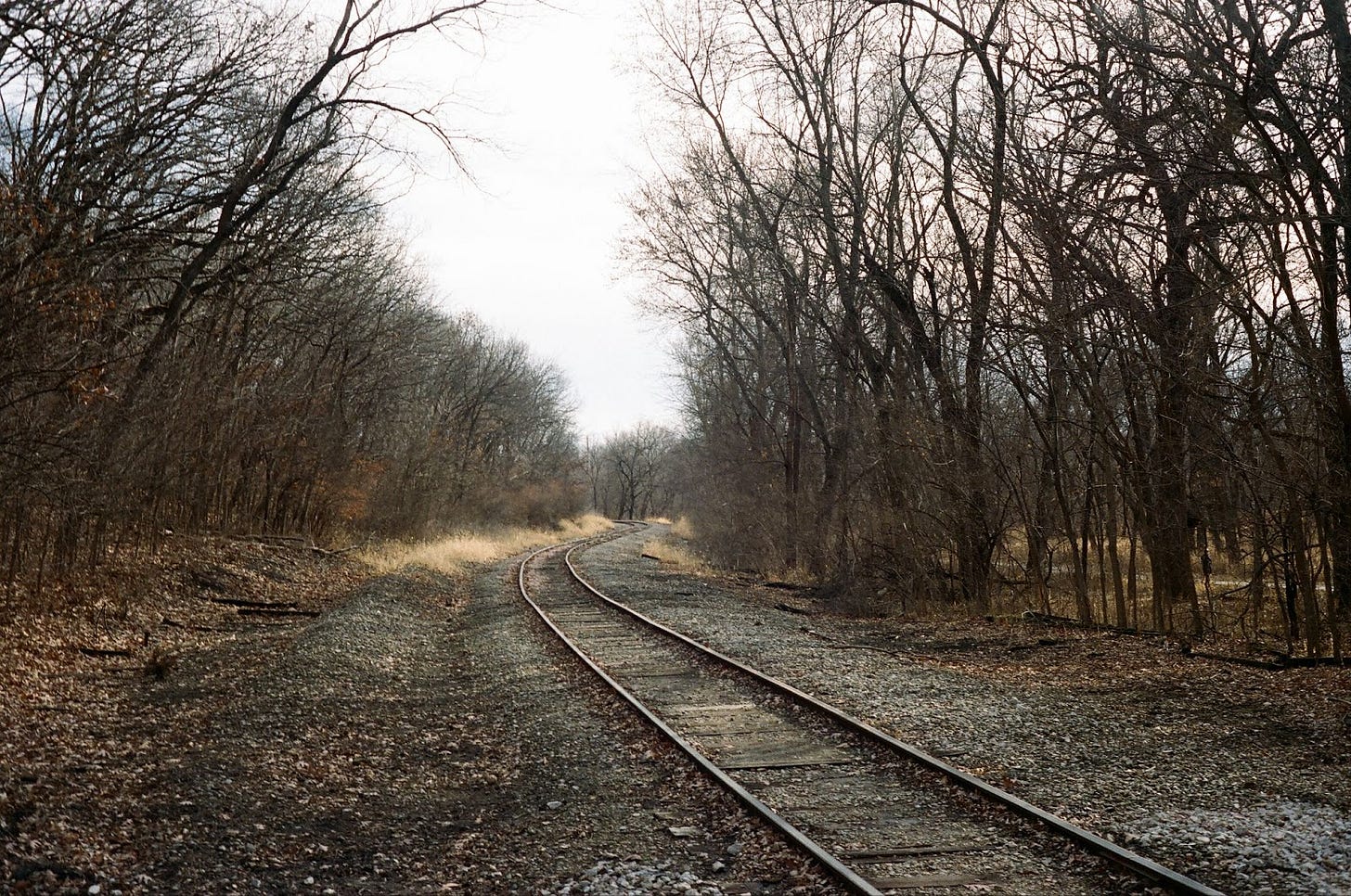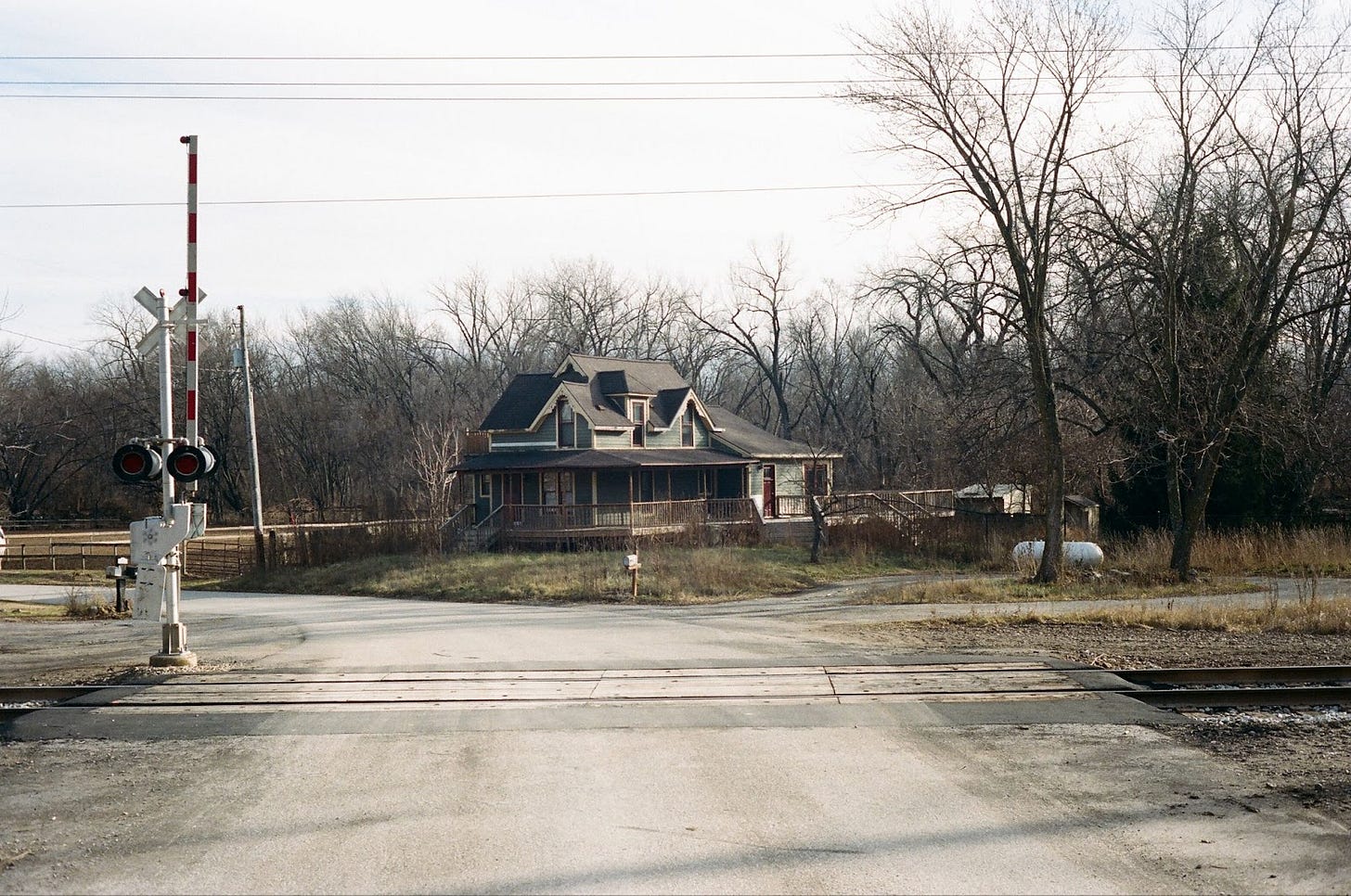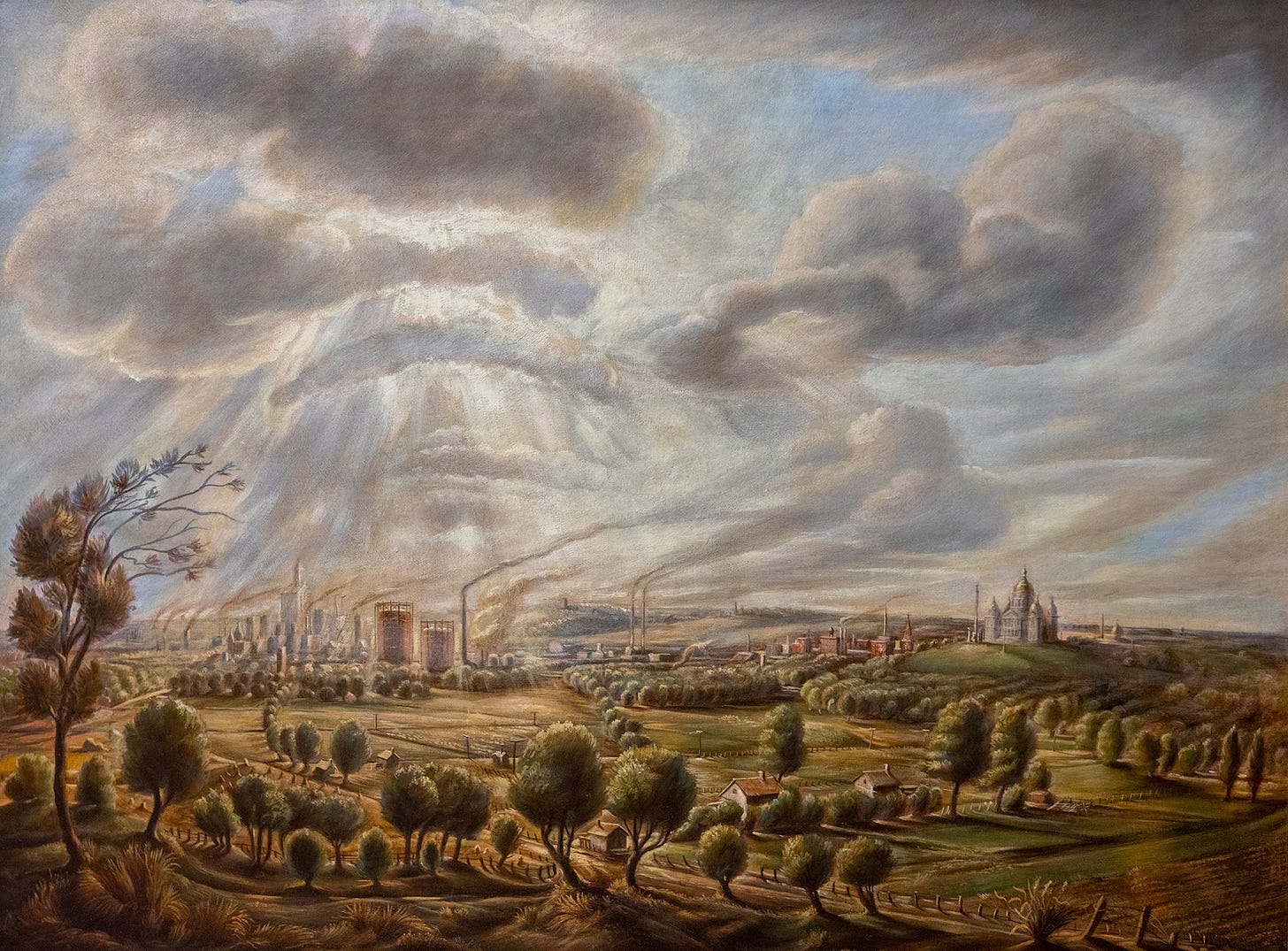Once the dust of holiday festivities had finally settled, I took off south with my face towards the sun. I was back in Des Moines—where I grew up—visiting family and overdue for a long walk.
Forgetting my sunglasses, I shielded my eyes, and placed my hand perpendicularly to my eyebrows. On occasion, I lowered my arm to meet the eyes of a fellow passerby. The motion could have easily been mistaken for a salute, but I was only saying hello. You see, Des Moines is a hello-town, where to not acknowledge the presence of another—even if you don’t wish to speak—feels rude.
I moved away from Des Moines thirteen years ago, for the big city, where saying hello to strangers wasn’t so common. A sincere hello was a novelty I looked forward to exercising today. I would give many throughout the day.
Alex Wolfe here, and this is Pedestrian—a newsletter for those who like to walk.
From my parent’s blue house in Beaverdale, I continued to the Des Moines Art Center off Grand Avenue where my mother enrolled me in art classes as a young boy. It was inside this limestone structure that I was exposed to works of art I once misunderstood, but learned to appreciate later in life, like the precariously fabricated sculptures of Richard Tuttle or the decaying paintings of Anselm Kiefer. I had not considered for some time that this institution was one of many stepping stones I walked, leading me to the life I live today.
I walked through the parking lot, saw a sidewalk running adjacent to the museum, said hello to a woman and her small dog, and passed the rose garden in the backyard. I carried on until reaching Greenwood Park—a green space I’ve long held dear throughout my years of absence. I paused in front of the Sylvan Amphitheater as my eyes scanned the empty rows of seating. I was alone, not a soul in the park, save for an older gentleman walking the perimeter of the pond. I held my camera to my face and looked through the rangefinder. I felt a space between the image and myself, soon deciding not to press the shutter button. Sometimes to notice is good enough.
I left my Fujifilm digital camera in my bag and carried an old Canon film camera around my neck. In recent months, I’ve grown to enjoy film, not just for the quality of images, but for the limitations it poses. Each roll allows 36 shots, relieving me of a subtle anxiety I feel when shooting digitally. I can no longer take pictures of everything as I would given my SD card has space. Instead, I must be more intentional. A roll of film has consequences. One photograph isn’t just a captured moment, but one less chance to capture a moment further down the road.
Each photograph poses a question. When I put my eye to the rangefinder, do I like what I see? I approach the image somatically, just as I would interpreting the hexagrams of the I’Ching. I sense the acute difference between wanting a photograph or feeling like I should take the photograph. The best images are those I do not hesitate to capture.
At one time in my life I would have told you this park was the most peaceful place on Earth. Throughout my twenties, my mind frequently returned in times of discomfort and distress. Greenwood Park was my representation of refuge and to return—I thought—would alleviate me of an existential dread weighing on my shoulders.
The park was a daydream carried just as you would a photo in your wallet. From my apartment in Brooklyn, I imagined myself sitting on a bench beside the pond during a summer’s day watching clouds drift across a cerulean sky while listening to the buzz of cicadas. I could hear the laughter of children playing in nearby Ashworth pool and at that moment—sitting in the untroubled pastures of Greenwood Park—I was carefree.
So quickly I blamed my discomfort on the places I’d chosen to live. Life would be so much easier—I thought—if I just packed my bags, left New York City, and returned to Greenwood Park. However, the dread I felt wasn’t so much a product of the city, but the conditions of being alive. No matter where I went, even if I returned to Des Moines, there I would be—myself—waiting.
Perhaps my quality of life would improve and I’d forget the pressures of big city living, but I’d still have to pay rent, make a living, aspire to be somebody, have unexpected conflicts, watch my family members grow old, and worry about my own health. Instead, I learned refuge was not about looking for something externally, or finding a new place to live, but finding acceptance and solace inside myself.
From the distant memories of Greenwood, I kept on to the Bill Riley Trail (not unlike the North Bank Trail in Richmond, Virginia for those who are familiar) running parallel to Walnut Creek and it’s eventual confluence with the Raccoon River, a tributary of the Des Moines River and technically part of the watershed of the Mississippi River some 160 miles away—or about eight days of walking—to my immediate east.
I’d chosen this direction, not for the selection of watercourses to appreciate, but for easy access to a pair of active train tracks operated by the Iowa Interstate Railroad. Having walked Des Moines for many years, I’d grown tired of my usual tricks—I was headed downtown looking for paths I’d never walked.
On the tracks, I was greeted by a fellow drifter. Hello, he mumbled, taking a drag of the cigarette between his fingers. Hey Guy. How do ya do? We continued. I was only sure we’d grown distant when I no longer heard the irregular rhythm of ballast shuffling beneath our feet.
I fixed my gaze to the ground, only stopping until I felt a presence return. Looking up, my eyes met a pair of horses watching from a stable as their tails swished side to side. I tip-toed along the tracks not to raise alarm until concealed by the brush of the forest once again. From behind the trees, I could see the top of the 801 Grand Building, the tallest in all of Iowa at forty-five stories. When completed in 1989, the building was the tallest in the Midwest between Chicago and Denver until surpassed by Omaha’s First National Bank Tower thirteen years later.
I’d not seen the 801 Grand from this vantage and wondered what the eight-sided pyramid at the very top would look like had the air of Central Iowa carried enough sulfur to cause the copper to turn a shade of verdigris in oxidation—as the architects intended. I pressed further down the tracks, using the edifice as my northern star, until hearing the distant chime of a train’s air horn just as I reached a level crossing.
An unpaved, private road overlapped the tracks and I traced its winding path until meeting the concrete of a residential sidewalk. I walked South of Grand—Des Moines’ most surveilled neighborhood—took a right beside a bush full of chirping sparrows and passed the Iowa Governor’s Mansion.
I followed the course of Grand Avenue, bisected the Pappajohn Sculpture Park, continued down Walnut Avenue, and stopped once reaching the Kirkwood Hotel on 4th Street. I grew up twelve miles away from this very intersection, in a rural suburb on the fringes of the Des Moines metro. Once getting my driver’s license, I escaped to 4th Street any chance I could. There I attended shows at the Vaudeville Mews and drank coffee in between sets at Java Joe’s.
Around the corner, on Court Avenue, was Frank’s Place, filled with the belongings of the late Frank Burnette, a retired attorney and co-owner of the Vaudeville Mews who lived in the back. All of the establishments I previously named are no longer in operation. The bail bonds businesses who relied on the nearby courthouse for their revenue have since moved. The parking lot across the street was redeveloped into a Hy-Vee grocery store and the defunct Randolph Hotel was converted into lavish apartments.
I watched the sun begin to set from across the Des Moines River. The sun’s rays reflected from the modest skyline’s surfaces, temporarily blinding me as I held the camera to my face once again. I was distracted by the gaggle of geese standing on the bank, knelt down to adjust my tripod, and felt the moisture of wet grass cover my knees. Fitting for a river bank—I thought—only to discover I’d not knelt in wet grass, but a pile of goose feces.
Passing the gold capped dome of the state capitol building, I crossed Martin Luther King Parkway and felt the creep of a certain sadness only felt when knowing something is soon to end. Like many trips home, I’d only felt that I’d arrived just as it was time to go. Another visit’s abrupt close. Tomorrow I would wake up in Des Moines, return to New York by airplane, and walk beneath a different sunset in a different time zone.
On the corner of SE 7th Street is a little red house built in 1885—discovered while on another walk summers ago. The home appears older than the rest of the neighborhood stock, or perhaps it’s the last to be renovated. I’ve made a habit of checking in, just as I do in Chicago, each time I’m in Des Moines.
The neighborhood—once colloquially known as the Southeast Bottoms—is among the oldest in the city. Isolated by a tangle of railroad tracks to the north and the Des Moines River to the south and east, the neighborhood has long been subjected to municipal neglect and persistent flooding.
Catty-corner from the red house is a large, vacant brick building. From 1906 to 1973, the building was home to the Roadside Settlement. The settlement house provided services to the poor, not unlike many settlement houses of the time (such as the Hull House in Chicago), including community laundry and baths, a nursery school and kindergarten, telephone service, and the city’s first library branch.
The Southeast Bottoms was depicted in a 1932 painting by William C. Palmer, an artist who grew up in Des Moines. Although he studied in Europe and New York City, he made frequent returns to the city, and painted numerous images of the landscape. The land looks much different now. The farmland once surrounding downtown Des Moines has been developed—as foreshadowed by the looming industrial buildings in Palmer’s painting. Many of the old brick buildings lining Grand, Walnut, Locust, and Court have been demolished in favor of new buildings lacking any soul or parking lots. Des Moines has a penchant for destroying its own history.
In nearby Cohen Park lies the Southeast Water Fountain, a relic of Palmer’s time. Since I discovered the fountain’s existence, it’s become a portal—an overlooked landmark transporting me to a Des Moines I never knew, but had only visited in old photographs and textbooks.
The fountain, placed in 1906, was one of the last remaining functional granite drinking fountains distributed by the National Humane Alliance. Hermon Lee Ensign, a philanthropist and animal welfare advocate, left much of his wealth to build the animal drinking fountains for any city that requested after his passing in 1899. The fountains were free of charge, just as long as the city provided water supply and maintenance. Between 1904 and 1912, over one hundred cities across the United States and Mexico took advantage of Ensign’s offer.
The stone used to produce the Ensign fountains was produced in Vinalhaven, Maine by the Bodwell Granite Company—the same quarry which supplied stone blocks for the Brooklyn Bridge; a tie which only strengthened the bond I felt with this relic of Des Moines’ past. I circled the fountain until growing dizzy, placed my hand in the bowl as would a priest before a baptismal font and watched the water slip between my fingers as I brought it to my face.
To the west, the sun approached the horizon. Hues of purple and pink echoed throughout the clouds. My thoughts were filled with the sound of water falling into the fountain’s bowl. Having stood for a long time, I felt the chill against my flush cheeks for the first time all day. I pressed the shutter button of my camera one last time, rewinded the film, and checked my phone. Eleven miles. Enough for today.
These old relics of mine. The little red house and the water fountain, my own anchors connecting the past with the present. I continue carrying them. At thirty-one I’m of an age where I’ve almost lived elsewhere longer than I’ve called this place home. I feel the elastic of a rubber band grow taut. The person I once was—full of youthful naivety—feels distant, but within reach.
At times, the heart aches knowing it cannot occupy two places at once. As I walk this city I feel the accumulation of time, just as the water collects in the bowl of a fountain. Each of my footsteps is to dip my hands back into the water again and remain in conversation—beneath a purple sky—with all those stepping stones I once touched, sending me down the path I walk today.
See you next summer, Des Moines.
Thanks for reading,
—A.W.
Brooklyn, NY 11220
P.s. thanks for following along in 2023. I have a lot planned for 2024 and look forward to sharing more walks with you. I appreciate all the kind words and support. It really means a lot. I wish you all the best in 2024.
If you enjoy this newsletter, please consider sharing with a friend. As always, I’m Alex Wolfe and this is Pedestrian.



















Really enjoyed this newsletter, Alex. I attended Iowa State from 1989 until the mid 90s and of course spent some time in Des Moines. The Java Joe’s coffee shop you mentioned, was that a fairly narrow, but deep coffee shop with a stage for the band at the back? If so, I’ve definitely been there, and it is where a friend of mine met his wife.
Alex, I live in Des Moines and thoroughly enjoyed this piece. As you described your walk I was right there with you picturing each object you encountered in my mind as you described it.. Thank you for this thoughtful tribute to your home town!